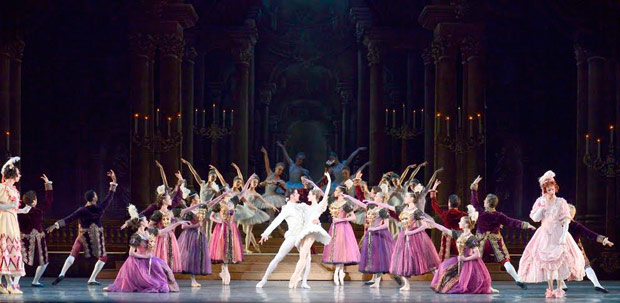
© Gene Schiavone. (Click image for larger version)
American Ballet Theatre
Cinderella
New York, Metropolitan Opera House
12 and 13 June 2014
www.abt.org
Ashton in Love
We’re so used to the pyrotechnics of Russian ballet, the speed and clarity of Balanchine, the muscular partnering of Kenneth MacMillan and the hard-edged physical extremes of William Forsythe et al, that it’s easy, at first, to see Frederick Ashton’s ballets as silly and fussy and a little bit retrograde. And, well, yes, they are all of those things, if one defines silliness as empathy for human folly, fussiness as a way of presenting the body as a complex mechanism with many parts – all of which move in subtle ways – and retrogression as a loving and sophisticated dialogue with the past. To fully enjoy Ashton, one has to be willing to acquiesce in one’s own softer impulses, a sense of wonder and perhaps a little nostalgia, and to surrender to the loveliness of small things.
It’s well worth the effort because Ashton’s world of flounces and bonnets and curlicued wrists is constructed with skill and detail and an abundance of choreographic imagination. Ashton’s ballets are enjoying a bit of a renaissance in the US at the moment, and this tide has brought Cinderella (1948), the choreographer’s first evening-length story ballet, to American Ballet Theatre. The company première is part of the company’s spring season at the Metropolitan Opera. (Cinderella is also danced by the Joffrey, whose sets and costumes, by David Walker, ABT is using.) After offering versions of the fairy-tale by Baryshnikov, Ben Stevenson, and James Kudelka, the company has finally settled on one that it can – and will need to – grow into. Some of the details of Ashton’s style – the shimmering footwork, the comic timing, and the through-the-body phrasing – are still being internalized by the dancers. But even this initial foray reveals a wealth of nuance, of emotional sincerity (and simplicity) and a mastery of storytelling that will reward repeated viewings.
Ashton responded to Prokofiev’s prickly score – by turns ominous and glistening, jagged and comic – with a ballet that is evenly split between comic scenes, touchingly simple interactions, and passages of lush, luminous classical dancing. The nasty step-sisters – more vain and ridiculous than evil – are played by men in drag, in the tradition of British pantomime, England’s response to Italy’s commedia dell’arte. Originally the roles were taken by Ashton and the Australian-born dancer and actor Robert Helpmann, both of whom were riotously funny. What is remarkable about this Cinderella is that these slapstick characters aren’t a sideshow but equal partners in the story, weaving in and out of the heroine’s world.
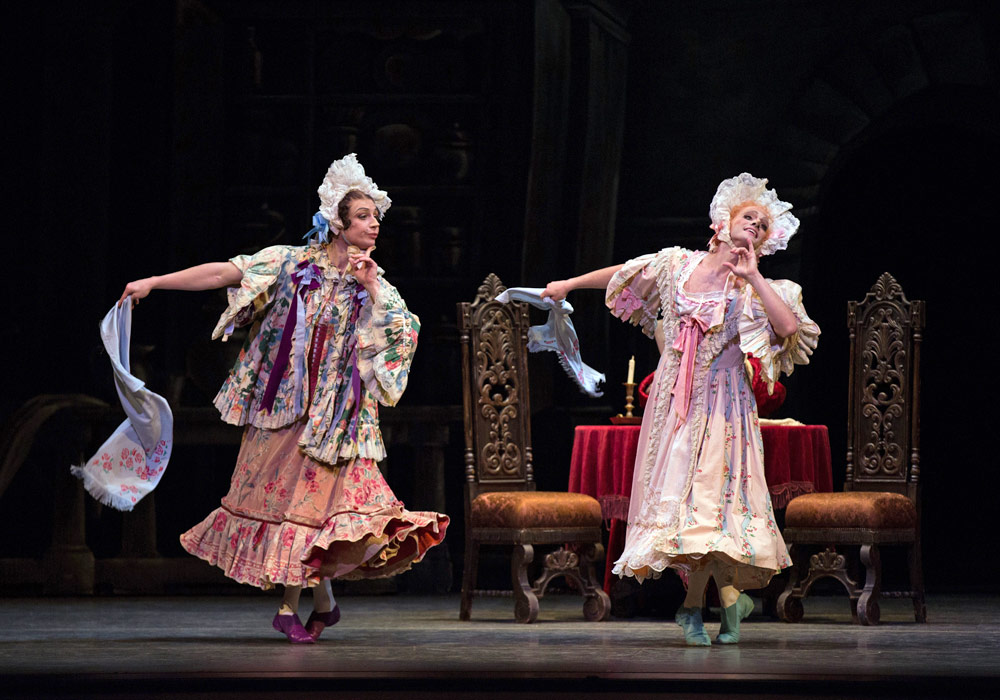
© Rosalie O’Connor. (Click image for larger version)
Then there is Ashton’s Cinderella, a victim who somehow manages, from the beginning, with her floor-skimming bourrées across the kitchen, to glow with inner warmth. As she dances with her broom, sweeping and popping into the air in sprightly pas de chats, we know instantly that she holds the key to life. Ashton embraces the fairy-tale, understanding that it is not, as Disney would have us believe, the story of a passive victim being saved by a handsome prince, but rather a lesson about the inalienable value of a good soul. Truth will out. He gives her a prince made to measure – a paragon of modesty and devotion, dressed in white, instantly smitten.
Around this foursome, Ashton deploys an army of secondary characters, some of them comic miniatures – like the mincing dancing master in the first act and a fatuous, toupee-wearing party-guest in the ballroom scene – others, classical figures straight out of Petipa. As in Sleeping Beauty, there are fairies, each with her own qualities, and a constellation of tutu-and-tiara-wearing stars. Broad humor and delicate late-nineteenth-century ornamentation coexist in complete harmony.
Unlike Balanchine’s majestic classicism, Ashton’s is warm, elaborate, full of twists and bends. How many ways can the torso bend, the arms waft, the shoulders tremble? How many versions are there of the warbling bourrée? How many variations on the pas de chat and the sissonne? Ashton uses them all. And this is the challenge: finding ways to soften contemporary ballet technique and rediscover these rounded, pliant shapes, phrase them, and give them life. Take the fairies. In the two performances I saw, only Sarah Lane, Skylar Brandt (both in the role of “Spring”) and April Giangeruso (as “Winter”) looked fully at ease in their solos. (Brandt was particularly tempestuous, like a starling flitting across the stage.) As the Fairy Godmother (a character very much along the lines of the Lilac Fairy in Sleeping Beauty), Veronika Part (June 12) used her back, shoulders, and head to sumptuous effect, but hadn’t quite mastered the sparkling footwork. In the other cast (June 13), Stella Abrera’s feet fluttered prettily, but she was less generous with the lilting movements of the upper body.

© Gene Schiavone. (Click image for larger version)
I saw two Cinderellas, Gillian Murphy (June 12) and Julie Kent (June 13). Both are quite familiar with Ashton’s style, having danced Titania in The Dream, among other things. The two are at very different points in their dancing lives – Murphy is at her peak, Kent is nearing the end of her career – and have always had contrasting styles. Kent is a subtle and touching actress who knows the value of stillness and of a well-placed accent. Her Cinderella was more delicate, wistful, fragile. Murphy’s interpretation had more impetuousness and more softness; the lines were rounder, creamier, and more fluid. (Her arms were particularly beautiful; they seemed to undulate slightly with her breath.) In the ballroom scene, neither had the shimmering quality one sees in films of Margot Fonteyn as she descends a staircase on pointe – like an apparition – and then glides forward as if carried by a zephyr. Perhaps that is a one-of-a-kind quality, or perhaps it is just a matter of time, of getting more comfortable with the choreography and molding the steps.
The same is true of the men playing the sisters, for whom Ashton has provided endless gags and silly dances, timed very precisely to the music. In the first cast, Roman Zhurbin and Craig Salstein hadn’t yet found their groove. Both are exceptional actors and comics, but the chemistry wasn’t quite right. The second cast, with Thomas Forster as the bigger, bossier sister and Kenneth Easter as the more submissive, awkward sidekick, worked better. Forster, who is exceedingly tall and lanky, played the part more like a man playing a woman. He was more himself, and perhaps for that reason the humor felt less forced.
But, quibbles aside, this Cinderella already has legs; with time it can only grow. The ensembles, full of weaving, blossoming, patterns, are already exhilarating. Both David Hallberg (June 12) and Marcelo Gomes make valiant princes. Hallberg’s lines are astonishingly pure, and his partnering has become very assured since he began dancing with the Bolshoi. Gomes is more ardent, and more dynamic. There is more force in his dancing. And he knows how to look like he’s in love.
Ashton wanted the audience to be convinced by the story, to believe in its magic. To that end, he knew how to be simple when it mattered. Some of the most heart-stopping moments are remarkably modest. A low, gliding lift in which Cinderella’s legs beat together slowly, like the beating of her heart; a circle of tiny turns she traces around her prince, like a moon orbiting around a planet. And the ending: the two lovers walk off, slowly, hand and hand, toward their destiny, never looking back. What else is there to say?












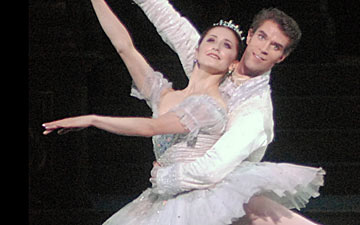
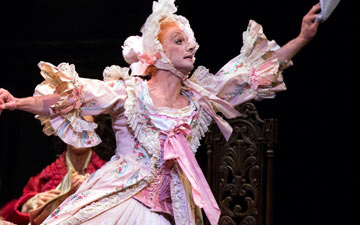

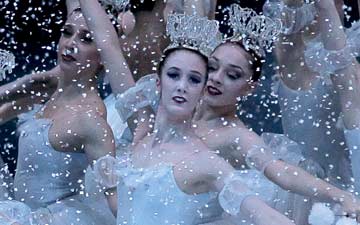
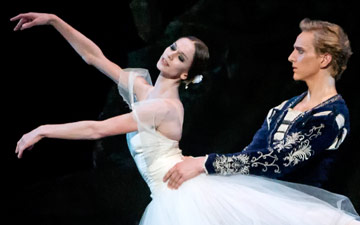
You must be logged in to post a comment.